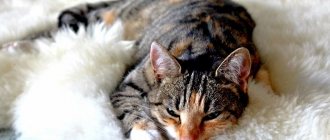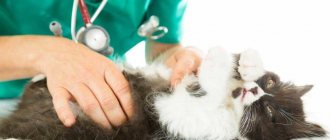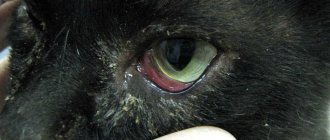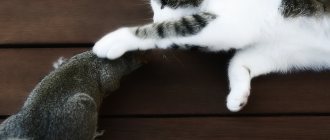What will you learn from the article?
- First aid What to do during an epileptic seizure
- Congenital causes
- When an animal needs medication
- Status epilepticus
- Diagnostic methods
- Prevention measures
Epilepsy in cats is a brain disorder that results in seizures with or without loss of consciousness. It is difficult to remain calm during an epileptic seizure. But this will have to be done - the life of a beloved pet depends on quick and competent human actions.
Veterinary neurologists urge owners to be calm in order to provide first aid - cats do not die during an attack.
First aid
A cat's behavior during a seizure is uncontrollable - the pet may accidentally injure itself. The owner must prevent possible injuries as much as possible.
What to do during an epileptic seizure
- Do not touch your pet or try to move it. The exception is the threat of falling from a height. If the cat has an attack on a windowsill, stairs or high furniture, lower it to the floor with a thick towel.
- Remove all objects that the cat could hit. Place pillows on the corners of furniture, table legs, and doorways to prevent your pet from bumping into them.
- In a room with a sick animal, turn off the lights and electrical appliances, close the curtains, and turn the TV to silent mode.
- Ask household members to leave the room.
- Stay calm, don't fuss, don't make noise, don't try to talk to your pet - this can increase the neurological reaction.
- Don't hold the cat. It is allowed to raise the animal's head with a towel and turn it on its side to protect it from injury.
- Under no circumstances should you put your fingers near the animal’s mouth; the cat will bite and will not be able to open its jaws until the attack is over.
- You should not put your hand into the mouth, trying to pull the tongue out - the tongue will not stick if the animal is lying on a flat surface with its head turned to one side.
- Record the start and end times of the seizures. If possible, take a video of the attack - this will help your veterinarian in further diagnosis.
- After the seizure ends, call your veterinarian for advice. If the attack lasted longer than 5 minutes, call a specialist at home.
Important!
Never try to open your cat's teeth with your fingers or a spoon. Do not insert any objects into the mouth - this will injure the animal and yourself.
What to do during an attack
If there are signs of the onset of an attack, you need to take the animal quickly to a room with a warm temperature, dimly lit. You should support the head with your hand so that the cat does not hit it on the floor during convulsions.
If the cat is not choking, there is no special need to unclench its jaws. If foam appears at the mouth, you should insert the tip of a spoon between the teeth to prevent your pet from biting its tongue. You should not press your cat to the floor during convulsions, this will only make them worse.
A sick animal should be protected from stress and a full examination should be carried out regularly.
ATTENTION! Many brands produce special food for epileptics; this is exactly what you need to feed a cat suffering from epileptic seizures.
There is no prevention for idiomatic type of epilepsy, because the disease can be genetic or caused by trauma. You can try to prevent only symptomatic epilepsy. To do this, you should regularly show the animal to the veterinarian and get tested.
It is necessary to exclude the possibility of injury to the cat or its contact with toxic substances. All medications, including anthelmintics, are given as prescribed by a specialist.
Reasons for appearance
Epilepsy manifests itself as uncontrolled muscle activity (convulsions) as a result of a temporary disruption of the normal functioning of the brain. The attack may be one-time or repeated with some frequency. In veterinary medicine, there are two groups of causes of epileptic seizures: congenital and acquired.
Congenital causes
- Congenital genetic abnormalities of the brain.
- Inbreeding is inbreeding. The first offspring is the most vulnerable.
- Birth injuries of newborns.
- Intoxication and infections during cat pregnancy provoke epilepsy in the kitten.
- Heredity. Breeding animals with defective genes.
Congenital causes of epilepsy in cats are identified solely by the results of diagnostic studies.
Acquired reasons
- Benign and malignant brain tumors.
- Traumatic brain injuries: bruise and concussion, contusion.
- Endocrine pathologies, hormonal imbalance.
- Heart failure.
- Bacterial and viral infections: infectious peritonitis, canine distemper, feline leukemia, rabies, bacterial meningitis.
- Lack of minerals (Mg, Ca) and vitamins (D, B2, B6, B12) necessary for the functioning of the nervous system.
- Stress. Fright.
- Endocrine pathologies.
- Prolonged fasting, violation of feeding regime.
- Helminthiasis is infection with worms.
- Urolithiasis, renal failure.
Important!
This group of causes is difficult to identify and is often not associated with a seizure. The attack and the cause that caused it can be separated by years.
What is epilepsy in cats
Epilepsy is a disorder of the brain associated with the processes of excitation and inhibition. These disorders are expressed by uncontrolled seizures, which can begin spontaneously and unexpectedly. In some cases, loss of consciousness is possible.
Possible causes of attacks
The exact causes of the disease are still unknown. They can be very different, ranging from genetic predisposition to stress during the first trip to the country. Determining the cause allows you to prescribe treatment and eliminate epileptic seizures or reduce their frequency to almost zero. The main reasons are:
- decreased blood glucose levels;
- hepatic encephalopathy;
- infectious diseases, inflammatory processes that affect the nervous system;
- ingestion of poisons and toxins into the body;
- any head injuries (attacks can begin a week, a month, a year or two after the injury);
- tumors in the brain, both benign and cancerous;
- diseases of the blood vessels, which can impair blood circulation in the head.
Factors contributing to the development of the disease
There is no actual connection between epilepsy and cat breed, but it has been observed that males are more likely to suffer from such disorders than females.
Epilepsy tends to be transmitted at the genetic level, but not necessarily from parents to kittens.
Epilepsy can be congenital or acquired
Danger to others
The attack itself is not dangerous to others (humans, other animals). But it is worth remembering that during convulsions, a cat can involuntarily injure its owner, so you should not press the pet to the floor or otherwise try to reduce the convulsions.
Treatment
Treatment of epilepsy in cats involves stopping seizures with anticonvulsants and achieving long periods of remission.
Lifelong remission is achieved in 15-30% of cats. In other animals, it is only possible to reduce the frequency of attacks and ease their course.
True epilepsy is not completely curable.
Only pathology caused by acquired causes can be completely cured by eliminating these causes.
When an animal needs medication
The decision to begin treatment for epileptic seizures is made by a veterinarian based on data on their frequency and duration. The cat owner must record this data and report it to the specialist.
Treatment is not required if epilepsy attacks occur 1-2 times a year and the cat does not have any chronic diseases. The owner must constantly monitor the pet and create a safe environment for it.
When attacks are repeated monthly or more often, last longer than 5 minutes, their severity increases - the cat needs help.
Medicines and the regimen for their use are prescribed by a veterinary neurologist. Incorrect choice of drug and its dosage can increase the severity, frequency and duration of the seizure.
Medications
The arsenal of medications for the treatment of convulsive seizures in cats is small due to their severe toxicity.
Veterinarians prescribe:
- Phenobarbital is an effective anticonvulsant in syrup and tablets. Reduces the excitement of the cat's nervous system, increases stress resistance, and prevents the onset of an attack. The dosage is selected by the attending physician. Sold by prescription.
The recommended dose is 1-2 mg per 1 kg of live weight 2-3 times a day.
Contraindications: chronic liver diseases.
Side effect: lethargy, drowsiness, thirst.
- Diazepam is a drug used to relieve epileptic seizures and reduce brain activity. Facilitates the recovery period after a seizure. Has a pronounced anti-anxiety effect. Prescribed in the form of rectal suppositories.
Recommended dose: 1 mg per 1 kg of live weight. The first dose is administered at the onset of seizures, followed by subsequent doses within 24 hours at 8-hour intervals.
Contraindications: chronic liver diseases.
Side effect: depression, excitability, abnormal behavior.
- Imepitoin (Pexion) is a new veterinary drug for the treatment of idiopathic epilepsy. Available in tablets (100 and 400 mg). Rarely prescribed due to insufficient clinical trials. It is quite well tolerated by cats.
Dosage: selected individually by a veterinarian after confirming the diagnosis of idiopathic epilepsy.
Contraindications: weight below 5 kg.
Side effect: loss of appetite, vomiting.
Important!
Human medications for epilepsy should not be given to cats.
What should the owner of a sick cat do?
Cats with true epilepsy require lifelong treatment and monitoring by a veterinarian.
Its owner must strictly observe the following rules:
- Strictly observe the dosage of the medicine.
- Give medications as prescribed by your doctor at the same time every day.
- Do not turn to traditional medicine - it is powerless against epilepsy.
- Do not interrupt treatment without your veterinarian's permission.
- Visit the clinic every month for a blood test.
- Conduct neurological examinations regularly - at least once a month.
- Keep an observation diary: record the date, time, nature and duration of attacks, behavioral changes before the attack.
Important!
With prolonged use of drugs, a cat may develop anemia; it is necessary to constantly monitor hemoglobin levels.
How to know if treatment is helping
The prescribed treatment regimen is considered successful if the cat has completely stopped having epileptic seizures or their frequency has been halved. There should be no side effects from the medications taken. In order for the veterinarian to assess the effectiveness of the medications, the owner needs to keep an observation diary. It documents the dates of attacks, their type, characteristics and duration.
The treatment plan is reviewed by the veterinarian if the cat's seizure frequency has not decreased by 50%. This can happen due to incorrect diagnosis, the animal’s individual reaction to medications, or incorrectly selected dosage.
If your cat has been seizure-free for more than a year, your doctor may prescribe a gradual reduction in the dosage of medications. Stopping antiepileptic drugs at once is not allowed - this causes “withdrawal syndrome”.
Prevention
Even with effective treatment, symptoms of epilepsy in cats may return, including seizures—an increase in frequency, duration, and intensity.
To reduce risks, it is important to follow your doctor's recommendations:
- balanced feeding. Exclude bones, fatty foods, raw fish and meat, flour, sweets;
- treatment against parasites, vaccination, regular preventive examinations;
- free range is prohibited. Walking on a harness is allowed if before the illness they did not cause alertness or fear;
- it is important to ensure that the windows are closed - an attack that begins on the windowsill can result in death as a result of a fall;
- avoid stressful situations - noisy companies, quarrels, loud music, repairs. During the acute period, the pet is isolated, not forgetting to check its condition;
- castration is mandatory - epilepsy is inherited, the hunting period provokes stress, pregnancy and childbirth aggravate the condition.
Treatment for epilepsy in cats will take several months before the seizures stop. In addition to providing first aid, it is advisable for the owner to be able to give injections, artificial respiration and chest compressions. It’s great if this knowledge is not needed, but it can save your pet’s life.
Types of epilepsy
Depending on the reasons that caused the pathology, epilepsy in a cat is divided into:
- Congenital (idiopathic). The causes of the congenital form of the disease are difficult to diagnose. The disease accompanies the animal throughout its life. Over time, without proper treatment, the severity and duration of attacks may increase. The cat requires lifelong monitoring and supportive care.
- Acquired (symptomatic). Seizures in cats are a consequence of head injuries or a complication of other diseases. If the root cause is identified and treated adequately, the animal has a high chance of recovery.
Symptoms
An epileptic seizure has several distinct phases, each of which has its own characteristic symptoms. Owners of cats need to know them in order to have time to provide first aid to the animal.
- The prodromal phase is preparation for an attack. It goes unnoticed by the owner. Lasts from several hours to 2-3 days. It is characterized by increased anxiety and nervousness of the animal.
- Harbingers (aura) - the animal reacts inadequately to its owners, gets scared by the slightest sound. The pet becomes absent-minded, lack of coordination, and slight muscle twitching are observed. The harbinger may be complete immobility of the pet. The duration of the period is from 1 to 30 minutes.
- A seizure (convulsive phase) is an epileptic seizure itself. Often begins in sleep. Characterized by large muscle spasms with deflection of the spine. The animal falls to the side. Partial numbness of the body is observed. The cat's breathing is heavy and intermittent. Possible loss of consciousness, involuntary defecation and emptying of the bladder. White or pink foam comes out of the mouth. The phase lasts from 2 to 30 minutes.
- The postictal phase is a period of recovery. The animal experiences weakness, lethargy and depression. Consciousness is confused, the cat does not recognize the owner, it gets scared. Increased appetite may develop. The recovery period may take up to 3 days.
In each cat, an epileptic seizure manifests itself in its own way, the phases last for different times, may be blurred, not clearly expressed.
Important!
Frequently repeated seizures lead to severe oxygen starvation and death (necrosis) of brain cells.
Status epilepticus
The most severe condition, leading to serious complications, including death, is status epilepticus.
This includes:
- Seizures that last more than 5 minutes.
- Seizures, during the intervals between which the cat does not have time to regain consciousness.
The danger of status epilepticus is that the animal’s brain experiences severe overload. Cats develop serious neurological pathologies and shorten their life expectancy. This condition requires prompt intervention by veterinary specialists.
Types of epileptic seizures
There are several types of epileptic seizures, but one should not assume that the same type will be exactly the same in different animals. In particular, seizures, regardless of their type, almost always involve the development of convulsive spasms of the limbs. Almost, but not always. Some cats do not experience convulsions. As for the duration, the “classic” of epilepsy is considered to be a short, fleeting seizure that lasts for a maximum of a minute. Again, in some cats the duration of attacks can be up to five minutes, even when the disease is not advanced. Due to the short duration, many owners may not even notice that something is wrong . In general, there is a very common misconception that cats with epilepsy will inevitably injure themselves during seizures. So here it is. This is truly a misconception. In just a few seconds of convulsive twitching, nothing outwardly will happen to the animal. Only his brain will suffer, which after some time will certainly manifest itself in the form of more frequent seizures.
Now we will look at the main varieties of the latter. Please note that the classification we have given is approximate; the boundaries of different types can be extremely blurry.
Localized seizures
They develop only when a small part of the cerebral cortex is affected. With localized seizures (if you start treating your pet in time, of course), there is hope for lifelong remission and maintaining the proper level of quality of life for the animal.
They appear as follows:
- Episodic movements. A classic example is convulsive twitching of the facial muscles, constant and “inappropriate” blinking. Cases have been described in which a cat’s head or one of its limbs “chronically” twitched.
- Signs of uncontrolled behavior of the autonomic nervous system are also characteristic. Simply put, cats with this type of seizure often exhibit excessive drooling, vomiting, and dilated pupils.
- Severe behavioral abnormalities are often observed. You may notice, for example, restlessness, anxiety, the cat constantly runs after other animals and people, and has panic attacks.
Generalized (generalized) seizures
Such attacks do not bode well for the animal, as they indicate serious damage to large areas of the cerebral cortex. Only in very rare cases do generalized seizures appear in an animal right away. Much more often, they are only a consequence of a gradual deterioration of the course of the disease, i.e. At first, a localized variety is observed in the pet. The main sign of a generalized seizure is loss of consciousness and a sharp increase in salivation. There are cases of involuntary defecation and urination. As a rule, the cat falls, the limbs on both sides of the body twitch convulsively and randomly. Separately, it is necessary to describe the characteristics of seizures that develop in these cases. They are tonic, clonic, mixed and myoclonic.
Let's briefly look at each variety:
- Tonic convulsions. The muscles tense sharply, this lasts from several seconds to several minutes.
- Clonic variety. Manifested by rapid and rhythmic muscle contractions.
- Mixed convulsions. First, the muscles contract with a tonic spasm, which after a while is replaced by clonic contractions.
- Myoclonic seizure epilepsy in cats. Similar to tonic, but characterized by sharp, sporadic contractions of the limbs. Often the spasms first cause the paws on one side of the body to clench and relax, after which they quickly move to the other.
But! In approximately 30% of cases, seizures are nonconvulsive. They are characterized by atonic attacks.
The cat's muscles suddenly lose rigidity, causing the animal to fall. If you feel the muscle tissue during a seizure, it will feel like liquid jelly. This condition is extremely dangerous, since if the attack lasts long enough, your pet may suffocate (the respiratory muscles also become relaxed).
Transitional varieties
In such cases, generalized and localized seizures alternate in different proportions. It is believed that these seizures are most common in cats with epilepsy. They proceed quickly, and at first even the animal itself (due to partial shutdown of brain functions) does not have time to understand what exactly happened to it. In addition, sometimes they happen in a dream. As a rule, all transitional types have clearly defined “triggers”, to identify which the animal should be carefully observed.
Diagnostics
Only a veterinary neurologist can identify the cause of the pathology - do not try to do this yourself. The diagnosis of epilepsy is made based on the results of many examinations and laboratory tests, based on your notes from the observation log and video recording.
Diagnostic methods
- Anamnesis collection.
- Visual inspection of the animal, palpation of areas that cause suspicion.
- Ultrasound of the abdominal organs.
- Cerebrospinal fluid puncture.
- Computed tomography (CT) or MRI.
- Cardiogram.
- Analysis of urine.
- Electroencephalography.
- Radiography.
- Blood chemistry.
An important role in making a diagnosis is played by the description of the pattern of the attack: precursors, duration, nature of seizures in cats, time to recover from the condition. Having received the results of all studies, the veterinarian makes a final diagnosis.











